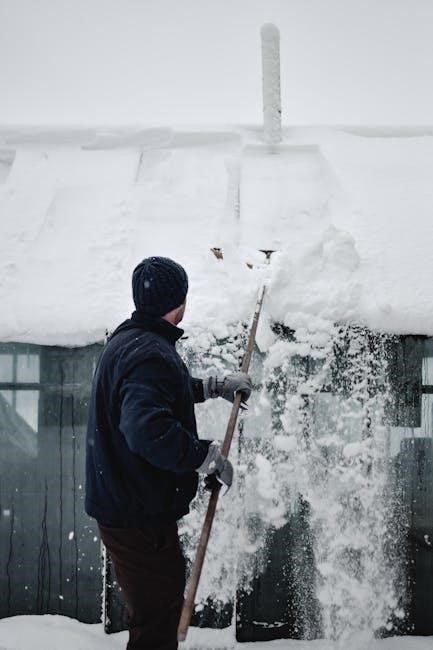Welcome to the 2․5 Tog Temperature Guide, your essential resource for understanding how to dress your baby for optimal sleep comfort and safety․ This guide helps parents navigate the complexities of baby sleepwear, ensuring the right balance of warmth and breathability․ Discover how to create a safe and cozy sleep environment tailored to your baby’s needs, with a focus on the 2․5 Tog rating․ Learn about room temperature, layering, and seasonal adjustments to promote healthy sleep habits․ This guide is designed to empower parents with knowledge, ensuring their baby sleeps soundly and safely․

What is a Tog Rating?
A Tog rating, short for Thermal Overall Grade, measures how well a fabric retains heat․ It is a standardized scale used to indicate the warmth of sleepwear, such as sleeping bags and blankets․ The higher the Tog rating, the warmer the product․ For example, a 2․5 Tog rating is commonly used for moderate temperatures, while higher ratings like 4;0 or 4․5 Tog are reserved for colder environments․ Understanding Tog ratings is crucial for ensuring your baby’s comfort and safety, as it helps prevent overheating, which can be dangerous for infants․ This guide focuses specifically on the 2․5 Tog rating, providing detailed advice on its use and application․ By grasping the concept of Tog, parents can make informed decisions about their baby’s sleepwear, ensuring a safe and restful environment․
Why Understanding Tog Ratings is Important for Baby Sleep
Understanding Tog ratings is vital for ensuring your baby’s sleep is both safe and comfortable․ Overheating is a significant risk factor for Sudden Infant Death Syndrome (SIDS), making it crucial to regulate your baby’s body temperature․ Tog ratings help you choose the right sleepwear for the room temperature, preventing your baby from getting too warm or too cold․ This balance is essential for uninterrupted sleep and overall health․ Additionally, knowing the Tog rating allows you to layer clothing effectively, adapting to seasonal changes without compromising safety․ By mastering Tog ratings, parents can create a sleep environment that promotes healthy development and peace of mind․ This guide provides practical insights into using the 2․5 Tog rating to achieve these goals, ensuring your baby sleeps safely and soundly․

How Tog Ratings Work
Tog ratings measure a fabric’s ability to retain heat, ensuring optimal comfort for your baby․ The Thermal Overall Grade (TOG) reflects how well a material traps warmth while maintaining breathability, crucial for regulating body temperature and preventing overheating․ Higher TOG values indicate greater warmth, while lower values suit warmer environments․ This system helps parents choose appropriate sleepwear based on nursery conditions, ensuring safety and comfort․ Understanding TOG ratings is key to selecting the right sleep products for your baby’s needs, promoting healthy sleep patterns and peace of mind for caregivers․
What Does 2․5 Tog Mean?
The 2․5 Tog rating refers to the Thermal Overall Grade (TOG) of a fabric, measuring its ability to retain heat while maintaining breathability․ A 2․5 Tog sleeping bag is designed for cooler room temperatures, typically between 16°C and 20°C (61°F to 68°F), making it ideal for spring, autumn, and cooler summer nights․ This mid-range TOG rating ensures your baby stays warm without overheating, providing a safe and comfortable sleep environment․ The 2․5 Tog is versatile and suitable for most home environments, offering a balance between warmth and airflow․ It’s a popular choice for parents seeking a reliable option for moderate climates․ By understanding the 2․5 Tog rating, you can dress your baby appropriately, layer their clothing effectively, and maintain a safe nursery temperature, promoting healthy sleep patterns and peace of mind for caregivers․
The Science Behind Thermal Overall Grade (TOG)

Thermal Overall Grade (TOG) measures a fabric’s ability to retain heat while maintaining breathability․ It is determined through laboratory testing, ensuring accurate ratings․ Higher TOG values indicate greater warmth, while lower values suggest lighter, cooler fabrics․ The TOG rating is crucial for baby sleepwear, as it helps prevent overheating—a key factor in Sudden Infant Death Syndrome (SIDS) prevention․ The science behind TOG involves understanding how fabrics trap warm air and release excess heat, ensuring a safe sleep environment․ By testing fabrics for thermal resistance, manufacturers can assign precise TOG ratings, guiding parents in choosing appropriate sleepwear for varying room temperatures․ This system ensures babies stay comfortable without risking overheating, making it a cornerstone of safe sleep practices․ The TOG rating is a reliable tool for parents to dress their babies according to seasonal needs, promoting healthy sleep patterns and peace of mind․
Understanding TOG empowers parents to create a safe and cozy sleep environment tailored to their baby’s needs․

2․5 Tog Temperature Guide
A 2․5 Tog rating is ideal for cooler temperatures, typically between 16°C and 20°C․ It ensures your baby stays warm without overheating, promoting safe and comfortable sleep․
Ideal Room Temperature for 2․5 Tog Sleeping Bags
The ideal room temperature for using a 2․5 Tog sleeping bag is between 16°C and 20°C (61°F to 68°F)․ This range ensures your baby stays warm without overheating, promoting safe sleep․ A temperature above 20°C may lead to discomfort, while below 16°C could make your baby too chilly․ Always check the nursery temperature accurately using a reliable thermometer to maintain this optimal range․ Dressing your baby in lightweight layers under the sleeping bag can help adjust to slight temperature variations․ Remember, a consistent room temperature is key to ensuring your baby sleeps comfortably and safely in their 2․5 Tog sleeping bag․
How to Measure Nursery Temperature Accurately
Accurate temperature measurement is crucial for your baby’s comfort and safety․ To measure the nursery temperature correctly, place a digital thermometer at least 1 meter above the floor and away from direct sunlight or drafts․ Ensure it’s positioned where your baby sleeps, not near windows or radiators․ Check the temperature frequently, especially during seasonal changes, to maintain the ideal range of 16°C to 20°C (61°F to 68°F) for 2․5 Tog sleeping bags․ Avoid using mercury thermometers for safety reasons․ By monitoring the temperature accurately, you can adjust your baby’s clothing and sleeping bag to ensure a comfortable environment, preventing overheating and promoting restful sleep․ Consistency in temperature monitoring helps create a stable sleep environment for your baby․

Dressing Your Baby for 2․5 Tog
Dressing your baby for a 2․5 Tog sleeping bag involves layering breathable fabrics to maintain comfort without overheating․ Start with a lightweight undergarment, then add a onesie, and finish with the sleeping bag․ Always monitor room temperature to ensure the perfect balance for your baby’s sleep․
What to Wear Under a 2․5 Tog Sleeping Bag
Choosing the right clothing for under a 2․5 Tog sleeping bag is crucial for your baby’s comfort and safety․ Opt for lightweight, breathable fabrics like cotton or bamboo to prevent overheating․ A simple onesie or a lightweight sleepwear set is ideal․ Avoid thick or heavy materials that could trap too much heat․ Remember, the goal is to maintain a comfortable body temperature without risking overheating, which can be unsafe for your baby․ Always check the nursery temperature and adjust the layers accordingly․ For cooler rooms, a thin fleece layer can be added, but ensure it’s removed if the room warms up․ This balanced approach ensures your baby sleeps soundly and safely․
Layering Clothing for Optimal Comfort
Layering your baby’s clothing is a practical approach to maintain optimal comfort, especially when using a 2․5 Tog sleeping bag․ Start with a lightweight base layer, such as a cotton onesie, to provide a breathable foundation․ Add a mid-layer like a thin fleece sleeper or footed romper for extra warmth without bulk․ Finally, the 2․5 Tog sleeping bag serves as the outer layer, offering the perfect balance of warmth and flexibility․ This method allows you to adjust clothing as room temperatures fluctuate, ensuring your baby remains comfortable throughout the night․ Remember to avoid over-layering, as this can lead to overheating․ Always check your baby’s comfort by gently feeling the back of their neck—if it’s too warm, remove a layer․ Layering ensures versatility and adaptability, making it easier to tailor your baby’s sleepwear to their specific needs․

Seasonal Considerations
The 2․5 Tog rating is ideal for spring and autumn when temperatures are mild, typically between 15-20°C (59-68°F)․ It provides the right warmth without overheating, making it perfect for transitional seasons․
Using 2․5 Tog in Spring and Autumn
The 2․5 Tog rating is particularly suitable for spring and autumn, when temperatures are mild but not overly warm․ During these seasons, room temperatures often range between 15-20°C (59-68°F), making the 2․5 Tog an ideal choice to keep your baby snug without risking overheating․ This Tog rating ensures that your baby stays comfortable as the weather transitions, avoiding the need for heavy winter layers or lightweight summer fabrics․
For spring and autumn nights, pair the 2․5 Tog sleeping bag with a lightweight onesie or pajamas to maintain the perfect balance of warmth․ Always monitor your baby’s room temperature and adjust their clothing layers accordingly to ensure their comfort and safety․ This versatility makes the 2․5 Tog a practical option for these intermediate seasons․
Transitioning Between Tog Ratings for Different Seasons
Transitioning between Tog ratings ensures your baby stays comfortable year-round․ As seasons change, so do room temperatures, requiring adjustments in sleepwear․ For warmer months (summer), a 1․0 Tog sleeping bag is ideal, while cooler seasons (winter) call for higher ratings like 4․0 or 7․0 Tog․ The 2․5 Tog is perfect for spring and autumn, offering a mid-weight option for mild temperatures․
Use a Tog rating chart to guide your choices, considering room temperature and your baby’s clothing layers․ Monitor nursery temperatures closely and adjust sleepwear accordingly․ For example, switch from a 2․5 Tog to a 4․0 Tog when temperatures drop below 15°C (59°F)․ Always prioritize breathability and avoid overheating, ensuring your baby’s comfort and safety through every season․ This flexible approach guarantees a restful and secure sleep environment․

Safety First
Understanding Tog ratings is crucial for preventing overheating, a key risk factor for SIDS․ Using the correct Tog rating ensures your baby maintains a safe and comfortable temperature, promoting a secure sleep environment․
Understanding Safe Sleep Practices
Safe sleep practices are vital for protecting your baby from risks like Sudden Infant Death Syndrome (SIDS)․ A key aspect is maintaining a comfortable sleep environment with appropriate bedding and clothing․ The 2․5 Tog rating plays a significant role in this by ensuring your baby doesn’t overheat․ Overheating can increase the risk of SIDS, so using a sleeping bag with the correct Tog rating is essential․ Additionally, ensure the nursery is at a safe temperature, typically between 16-20°C, and avoid using loose bedding or blankets․ Always place your baby on their back to sleep and keep the crib free from soft toys or pillows․ By following these guidelines, you create a secure and comfortable space for your baby to sleep safely․ Remember, consistency and awareness are key to maintaining safe sleep habits for your little one․
How Tog Ratings Prevent Overheating
Tog ratings are a crucial tool in preventing overheating, a key risk factor for Sudden Infant Death Syndrome (SIDS)․ The Thermal Overall Grade (TOG) measures a sleeping bag’s ability to retain heat, ensuring your baby stays warm without overloading․ A 2․5 Tog rating is designed to maintain a safe temperature range, typically between 16-20°C, preventing excessive heat buildup․ By choosing the correct Tog for the room temperature, you avoid the dangers of overheating․ Lighter Togs are ideal for warmer rooms, while heavier ones are suited for cooler environments․ This balance ensures your baby’s comfort and safety, promoting a restful sleep without risks․ Always check the Tog guide to match your baby’s sleepwear to the nursery temperature, creating a secure sleep environment․

Practical Tips for Parents
Check nursery temperature daily, use a TOG chart for guidance, dress baby in breathable layers, ensure sleep bags fit properly, and monitor comfort to adjust clothing as needed for optimal sleep safety and comfort․

Using a Tog Rating Chart for Guidance
A Tog rating chart is an invaluable tool for parents to ensure their baby’s sleepwear is appropriately matched to the nursery temperature․ These charts typically correlate room temperature ranges with specific Tog ratings, helping you choose the right sleep bag or bedding․ To use the chart effectively, start by measuring the nursery temperature accurately․ Once you have the temperature reading, refer to the chart to find the recommended Tog rating for that range․ For instance, a 2․5 Tog sleeping bag is ideal for rooms between 16-20°C․ The chart will also guide you on layering clothing underneath, such as a lightweight onesie for warmer rooms or a thicker sleeper for cooler environments․ By following the chart, you can prevent overheating and ensure your baby stays comfortable and safe․ Regularly updating your approach based on seasonal changes will further enhance your baby’s sleep quality․
Common Mistakes to Avoid When Using Tog Ratings
When using Tog ratings, it’s essential to avoid common mistakes that could compromise your baby’s comfort and safety․ One of the most frequent errors is ignoring the nursery temperature, leading to overheating or overcooling․ Many parents also overlook the importance of layering clothing correctly, either adding too many layers or too few․ Another mistake is not adjusting the Tog rating seasonally, failing to switch between lighter and heavier sleep bags as temperatures change․ Additionally, some parents rely solely on the Tog rating without considering their baby’s individual needs, such as their weight or activity level․ Finally, neglecting to check the accuracy of the nursery thermometer can lead to misguided decisions․ By avoiding these pitfalls, you can ensure your baby sleeps safely and comfortably, making the most of the Tog rating system․
The 2․5 Tog Temperature Guide offers a comprehensive approach to ensuring your baby’s sleep is safe, comfortable, and tailored to their needs․ By following its insights, you can create an ideal sleep environment, avoiding common mistakes and promoting healthy sleep habits for your little one․
Final Thoughts on the 2․5 Tog Temperature Guide
Resources for Further Reading
For further understanding of the 2․5 Tog Temperature Guide, explore the following resources․ The British Standards Institution provides detailed insights into the official TOG testing standards, ensuring accuracy․ Websites like The Lullaby Trust offer comprehensive sleep safety guidelines, emphasizing the importance of appropriate Tog ratings․ Additionally, Love to Dream and The Little Green Sheep provide product-specific guides, including TOG charts and temperature recommendations․ These resources are invaluable for parents seeking to optimize their baby’s sleep environment․ Websites like Which? and BabyCentre also offer unbiased reviews and tips on choosing the right sleepwear․ By referring to these resources, parents can make informed decisions to ensure their baby’s comfort and safety, aligning with the principles outlined in this guide․
